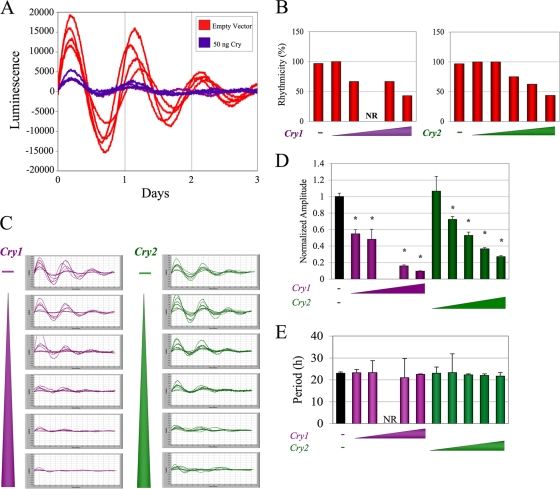FIG. 6.
Constitutive Cry expression does not abolish rhythmicity or alter period length but decreases rhythm amplitude. (A) Bioluminescence traces of cycling cells. NIH 3T3 cells were transfected with Per2-luciferase, Clock, and Bmal1 and then either 50 ng Cry1 or an empty vector. (B) Quantitation of culture rhythmicity. Cultures were transfected with constructs as indicated for panel A and also with various doses (1 to 100 ng) of Cry1 or Cry2. After synchronization, bioluminescence was recorded. Traces were detrended and analyzed using a chi-square periodogram (P < 0.001). Cultures were considered rhythmic if the periodogram analysis yielded one significant peak in the range of 15 to 35 h. The bars represent the averages of results from 4 to 12 culture dishes. (C) Records of rhythmic cultures from the experiment whose results are shown in panel B. The triangles represent increasing doses of Cry, with the highest dose at the bottom. (D) Quantification of rhythm amplitude. The amplitudes of the rhythms of the data in panel C were determined. While the cultures transfected with 10 ng of Cry1 exhibited some fluctuations of luciferase activity, no significant period length was detected. Amplitudes of all cultures were normalized to the average amplitude of cultures without Cry within the same experiment. Cultures transfected with all doses of Cry1 and all doses of Cry2, except 1 ng, exhibited rhythms with significantly decreased amplitude (ANOVA, P = 1.34 × 10−19; *, P < 0.0001). (E) The period of each rhythmic culture shown in panel C was determined by chi-square analysis. No significant difference in period was detected (ANOVA; P < 0.26). NR, not rhythmic.

